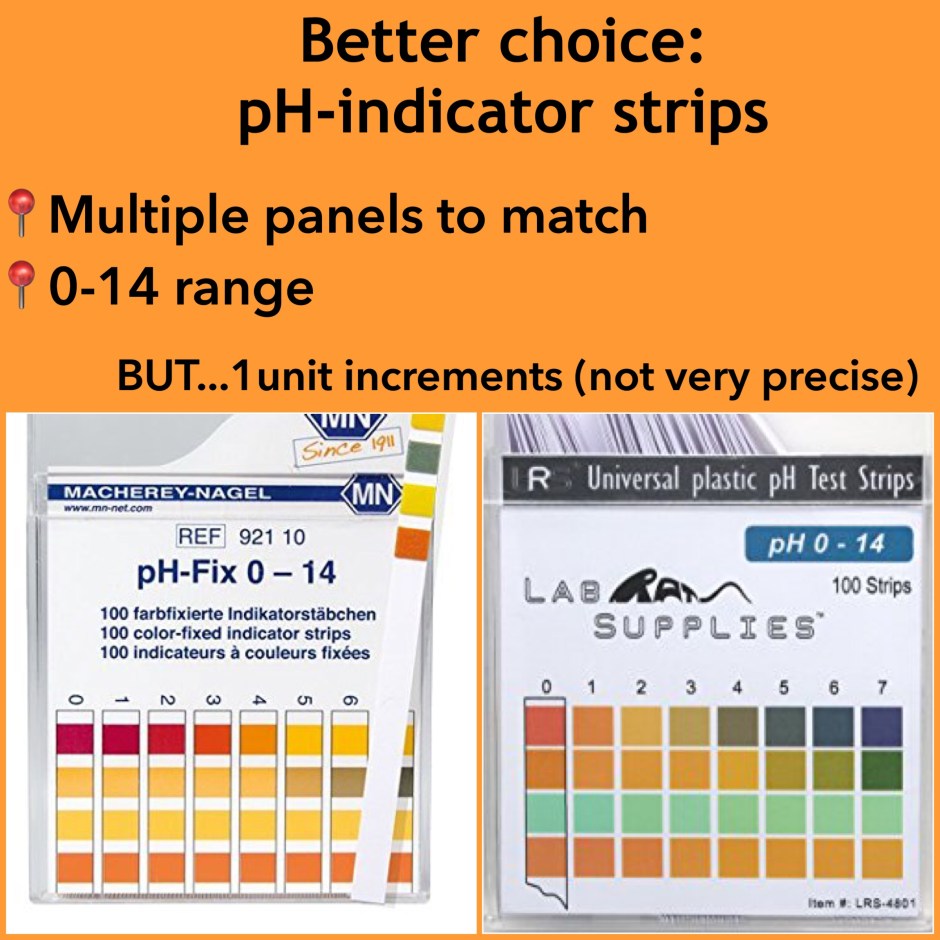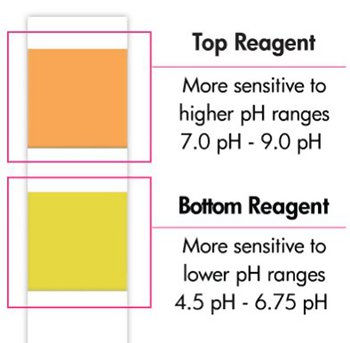* indicates an Affiliate link
Supplies – pH Test Strips
In terms of testing cleansers, all you really need is some pH-indicator strips. But not all strips are created equal, as I have learned through trial and error. The good news is that you can get good test strips for pretty cheap and unlike pH-testing meters (which I will cover later in this post) they don’t need any calibration, set-up or maintenance so you can start testing your products right away!
*this page contains affiliate links. These are denoted with an asterisk.
Tip 1a: Avoid pH-indicator “papers”
I’ve included two examples of pH-indicator papers below that I would avoid. Sure they are cheap…but they just aren’t very accurate, it is really hard to get a clear reading sometimes, and having only one color to compare your results to only contributes to their inaccuracy. Don’t waste your money on these.
Tip 1b: Go with pH-indicator strips (instead of papers)
These have a couple key advantages.
- They contain special indicator dyes that won’t bleed or dilute.
- They are highly accurate.
- The pH “reaction zone” (the color squares you will see) is backed by a transparent carrier film – so you can gently wipe off accumulated material and read the pH without damaging the strip.
But not all pH-indicator strips are created equal… so we will turn to those next.
Tip 2: Choose pH-indicator strips that have at least two colors for points of comparison

Look for test strips that have at least two colors. Some example strips include:
0-14 pH 1.0 accuracy – 4 colors 100/box ($12.99)
0-14, 1.0 Accuracy – 4 colors 100 ct ($11.99)
0-14 1.0 Accuracy – 4 color 100 ct ($15.59)
The benefit to these strips is that they cover entire pH range (0.-14), BUT the downside is that they are in 1 unit increments, so they aren’t as precise.
Since I really wanted to be able to look at .25 and .5 increments, I opted for other strips.
Tip 3: Find test strips with more precise units (.25 to .5)
In order to get more precise units, you will most likely need to have a reduced range. A common range is 4.5 to 9.0, which should work nicely for most cleansers that you test. Having more precise increments was important to me because I want to find a cleanser that is no higher than pH =5.5 (I will be posting a separate post all about pH levels..). So, I don’t want a cleanser to be 6.0. But if a strip has 1 unit increments there will be no way for me to know.
Here are some test strips that I recommend (I have the first one on the list).

- GRF Diagnose 4.5-9.0 Test Strips* ($9.99/200 count)These are great and cheap way to start testing pH values. They also appear to be very accurate because I have confirmed similar readings from these strips with my digital meter.
- GRF 4.5-9.0 Clearly Read and Accurate Testing pH Test Strips* ($9.99/100 count)These have three color reagents instead of 2. I’ll likely buy these when my current strips run out.
- pHresh Products pH Test Strips* ($18.72/80 count)These strips are very interesting to me because the company says which color reagent is more sensitive to various pH ranges. I have done some digging, but I can’t find out if that is true for pH test strips from other brands. But that would help when faced with a situation where the top and bottom color suggest different pH values (more on that later).
**Update: I was making sure the products were still available 3 years later, and some aren’t. So here are some other options!**
Testing Process
I usually will use about 4 test strips per cleanser test.
If you want to see the results of my cleanser tests so far, search the hashtag #GTGGphtest on Instagram.
- First I put two test strips directly in the cleanser (gently wiping off excess cleanser if needed).
- Next I mimic face washing by putting the cleanser in my hands and adding two tiny drops of water (this is particularly helpful for cleanser that are thick or super creamy and hard to test in step 1).
- Compare the strips to confirm matching results. If strips show different results, I report both. 95% of the time both the strips without and with water added show the exact same reading.
- Some cleansers are quite different when water is added so you will see different readings across the strips. That has less to do with the pH of the tap water than it does the formulation of the product.
- To find the pH level, match up the colored panels to the color guide on the packaging.
- There may be times (especially if your strips are in 1 unit increments) where some of the panels will match one pH level and the other panels will match the next level up. This usually indicates that the actual pH falls somewhere in between.
Also: You might want to check out holysnails’ blog for even more great tips for testing.
Supplies: pH Digital Meter
I started out with test strips, but soon I wanted to have greater accuracy with my results. Also, my test strips are for a reduced pH range (which is ideal for testing cleansers) but I wanted to also test my acids, which meant that I needed something to test below 4.5. Importantly, for pH-dependent products such as acids (LAA, BHA, AHA, etc.) less than a .25 difference can impact whether it is within its “effective range” or not. So basically I wanted more precision and less guessing.
Tips for what to look for in a meter
- Get one with a measuring pH Range: 0.0 – 14.0 pH.
- Make sure the meter is waterproof (seems obvious but some aren’t waterproof in terms of the entire device. So when you wash off the probe you have to be extremely careful not to get the top portion of the meter wet, which is annoying).
- Look for a Resolution or 0.1 or .01 (.01 is preferred for increased precision)
- Look for one that has at least .1 reliability (but .01 would be the ideal)
- Look for one with a skinny base or you will end up having to use A LOT of your product–and no one likes wasting products! (Look at the size of the base from the first meter I tried out and you will see an example of what you should avoid)
- Get one that comes with a buffer solution.
- If the meter includes calibrating packets or liquids that is great–liquids are better than packets only because packets are one-time use and you have to recalibrate roughly every two weeks so you will need to buy more packets.
- If you want to read another blog on the topic, check this one out:
Here is the first meter I bought and then promptly returned after it stopped working after a couple uses.

I’m actually glad I was forced to return it because it was SO frustrating to use because in order to test a product I had to use a pretty wide beaker to fit the base. The product needs to cover the entire probe (the glass ball) so I had to use a lot of product, which wasn’t ideal.
Lucky Stone PH Meter Digital PH-009 Water Quality pH Test Pen
Pros: This was cheap: $12.99 (But you get what you pay for)
My current Digital Meter
Apera Instruments PHB-3 Economic Waterproof pH Pocket Tester*

Here is the one that I ended up buying. I wish it went to the 2nd decimal place, but I was willing to sacrifice that to not have to spend more money.
Specs:
- Price: $39.95 (but there is a sale on Amazon right now that makes it $34.32)
- pH Range: 0-14.0
- pH Resolution: 0.1
- pH Accuracy: ±0.1 (ideally I would have liked to have one with an accuracy of .01 but that made the price jump up, but see the option below for one with better accuracy)
What I like about it:
- The thing I love about it is that it has a skinny probe area which allows me to test products in those little Nordstrom or Sephora sample jars and not waste product.
- Comes with a carrying case
- It is waterproof
- Comes with premixed calibration solution (pH 7.00) that I can use multiple times (ensuring that my meter is always calibrated properly)
- It has consistent readings the past 10 times I used it, so that is promising! I think I found a winner 🙂
Other options that I debated between:
Apera Instruments AI209 PH20 Value Waterproof pH Pocket Tester* ($48.75)

- This is a great model, and I nearly bought this one but I wanted to save some money and I thought that the model I bought had a smaller probe area (which was the major selling point for me). But this probe is also small.
- pH Accuracy: ±0.1
- pH Range: 0.0 to 14.0
- pH Resolution: 0.01
- This nearly made me choose this one because I really wanted the meter to report to the 2nd decimal place
- Comes with 2 calibration solutions and a carrying case
- Waterproof
- Also tests temperature
Apera SX610 Waterproof pH Pen Tester* ($54.00)

- Key selling point for this one was the very small probe tip so that you don’t have to waste a lot of product. But it seemed like the one I bought had a similarly small probe and was cheaper. I also really liked that this one came with two buffer solution liquids instead of just one.
- pH Range: 0-14.0
- pH Resolution: 0.1
- pH Accuracy: ±0.1
If you really want the top of line meter, here’s what I would recommend:
Extech PH100 ExStik* ($82.67)

- pH Accuracy (this is where this meter really shines): ±0.01pH
- pH Resolution: 0.01 pH
- LCD display shows pH from 0.00 to 14.00, temperature and bargraph of trends in acidity or alkalinity
- Device stores and recalls up to 15 labeled readings
- CAL feature tells you when it and time to recalibrate your meter (which is pretty cool)
- pH Range: 0.00-14.00
- Basically, if you can afford it, this would be the meter that I recommend. Is it absolutely necessary to get accurate readings of your products? No. But it would help to be as precise and accurate as possible. For most people this would be overkill, but that doesn’t mean I wouldn’t have loved to get this one! **UPDATE: Now that I have had my meter for 3 years and it has performed perfectly fine I wouldn’t spend the extra money on this**












